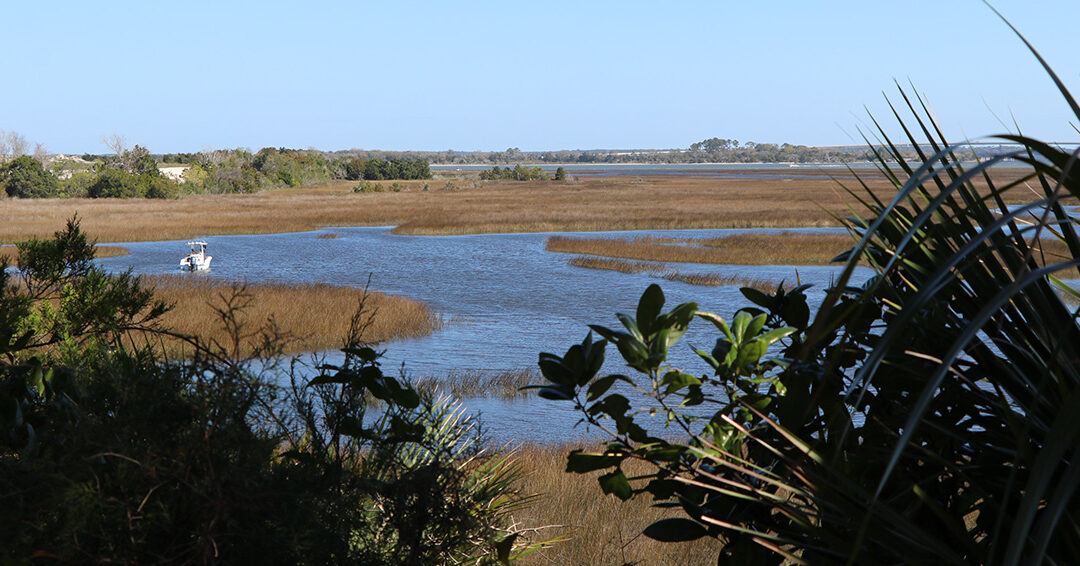In observance of the upcoming National Estuaries Week (September 16-23), St. Johns RIVERKEEPER (SJRK) celebrates the St. Johns River Estuary. The Lower St. Johns River is a 100-mile estuary that runs from its confluence with the Ocklawaha River in Welaka until it flows into the Atlantic Ocean at Mayport. Estuaries are transition zones between ecosystems and an area where freshwater and saltwater meet and mix.
The St. Johns River Estuary performs many critical functions: it supports healthy and economically important commercial and recreational fisheries, maintains good water quality, and provides resilience for future sea level rise. Robust estuarine submerged grasses and wetlands protect our shoreline, prevent erosion, and provide flood control and biofiltration. Estuaries are essential nursery grounds for 90 percent of the commercially important species we like to eat, such as crabs, shrimp, and oysters, as well as many species of fish.
Get out and explore the St. Johns River Estuary by water, by bike, by foot or by enjoying a real Florida fish camp featuring the bounty of the St. Johns. Visit ExploreTheStJohns.com to find your next adventure along the river!
We also have to do our part to save the St. Johns River Estuary. Today, it is under threat due to climate change and man-made alterations.
Threats to our Estuary
Climate Change
- Rising sea levels are making storm surge events worse, causing more septic tanks to fail, undermining infrastructure, pushing saltwater further upstream, and threatening the health of our river and our communities.
- As a result of more intense rainfall and hurricanes, frequent flooding increases stormwater runoff, flushing more pollution and sewage into our waterways – this threatens our health, our quality of life and our economy by fueling more blue green algae outbreaks that can be toxic and block much-needed sunlight from the river’s submerged grasses.
Man-Made Alterations
- Dredging the river increases water levels and storm surge, making the impacts of climate change worse, increasing water levels and driving saltwater intrusion further upstream.
- Clearing land for development and destroying wetlands reduces habitat and biodiversity, making ecosystems more vulnerable to collapse. We also lose the ecosystem services wetlands provide that help us combat climate change. Wetlands naturally store and treat flood waters and sequester carbon.
- Flow from the Ocklawaha River historically helped maintain the salt and freshwater balance in the downstream St. Johns River Estuary needed for healthy habitat. In response to the reduced freshwater flow from the damming of the Ocklawaha River and increasing saltwater intrusion, the submerged aquatic vegetation is disappearing, the cypress forests are stressed, and commercial and recreational fisheries are declining.
- Solution: Breaching the dam and restoring the natural flow would enhance water quality and habitat in the Lower St. Johns River by augmenting low flow, increasing dissolved oxygen, and providing a more balanced nutrient supply.
Canary in the Coalmine
- Submerged aquatic vegetation (SAV) is the St. Johns River Estuary’s canary in the coalmine – serving as an indicator of improving or degrading water conditions.
- Following Hurricane Irma in 2017, scientists concluded that the vast majority of SAV has disappeared in the Lower St. Johns River, including within Putnam County, with estimates as high as 99% (Virnstein, 2022).
- SAV diversity and abundance in the St. Johns have not bounced back since Hurricane Irma due to compounding stressors, but there are signs of recovery and for hope. SJRK’s SAVe our River’s Grasses August 2023 Expedition Field Log will be released during National Estuaries Week, and will provide our most recent update on the topic.
- Solutions do exist and comprise a mix of restorative, protective, and preventative measures and policies. These include freshwater flow restoration, nutrient pollution reduction, land and water conservation, resilience efforts, protective development strategies, and protective barriers.
Celebrate National Estuaries Week
Our St. Johns River Estuary is abounding in natural beauty, wildlife, and wetlands that are essential to our watershed’s ecosystem. We encourage you during National Estuaries Week to get out and enjoy the river, and to help us in our efforts to advocate for a cleaner, healthier estuarine system – for the river, and for us all!
Follow us on Instagram, Facebook, LinkedIn and Twitter to learn more about our estuary throughout the week, and how you can help.
